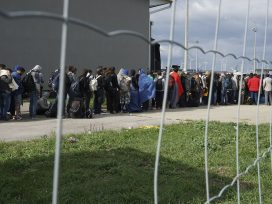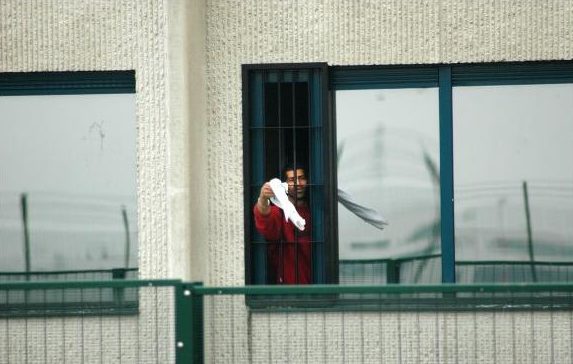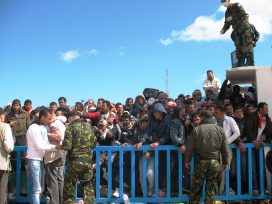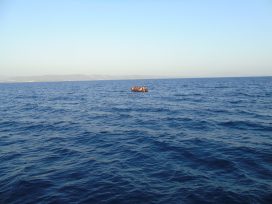The activist world condemns the management of immigration: the repression of collectives, the incarceration of migrants, criminalization, abuse of power, failure to respect the law, and so on. While state authorities condemn abuses of immigration laws, activists and their associations condemn the abuse of international conventions that guarantee rights such as the right to asylum or to family reunification. In turn, the European Union has been condemned for its policy of militarizing its borders, for its deals with (quasi-)dictatorial countries and for its policy of externalization.
This apparatus of control stands accused of destabilizing the lives of thousands of migrants who have been denied the right to asylum or to family reunification, and who consequently find themselves at the mercy of a technocratic power with political and ideological motivations. This state of insecurity is the result of a regime of ‘deportability’ that is imposed on them, thus subjecting them to exploitation.
Immigration management follows the same old lines that have been used for roughly a century. According to this model, foreigners are a commodity for a state to treat as it sees fit. In periods of economic growth, it turns to a complementary foreign workforce, only to lay off and expel the same foreigners in periods of low economic growth. This regime can only work if foreigners are viewed as inferior, at any rate in terms of rights.
This ‘inferiorization’ is now a classic trope of immigration rhetoric: we talk about ‘bogus asylum-seekers’, ‘economic migrants’ and ‘illegals’ – an entire vocabulary to insinuate that these people not only do not deserve the right to stay in Belgium, or Europe, but more than that to conjure up the spectre of the dishonesty of foreigners. This discourse makes it easier to amalgamate notions of foreignness and criminality, and tends to denote outsiders as a threat. The implication is that they deserve the repressive measures imposed upon them.
But there is also a second trend that reinforces the apparatus of control in the sphere of immigration, even though at first sight it seems to contradict this process of ‘delegitimation’: humanitarian reason. This tendency dictates that only ‘vulnerable’ people can have access to rights of residency or to the protection and help they need. Thus, in most cases, asylum applicants must show proof that they have been individually persecuted, even if they have come from a conflict zone. Marks indicating physical violence or torture are all pieces of evidence etched on the body of the applicant, serving to prove the veracity of his or her story.
Although these vulnerable people indeed deserve particular care and attention, and stronger protection, the humanitarian tendency reinforces this tendency of delegitimation. It does so for several reasons. First, because it makes yet another distinction between ‘good’ and ‘bad’ immigrants. During the refugee ‘crisis’ in autumn 2015 and the numerous citizens’ rallies of support, this dichotomy was embodied in the distinction between asylum-seekers, who were entitled to help, and the ‘undocumented’, who were ultimately denied the help of the citizen movement. Second, the humanitarian tendency reinforces suspicions towards foreigners. Indeed, humanitarian aid boosts the state’s moral superiority and underlines the illegitimacy of the object of its repressive measures.
The Syrian ‘crisis’ offers us another example. The Junckers, Merkels and Trudeaus of this world can boast of their moral superiority thanks to their management of the influx of Syrian refugees – reallocating them on a European scale in Juncker’s case, and offering them an unconditional welcome in the case of Germany and Canada. Autocratic or populist regimes, on the other hand, pursue policies that reinforce the public opinion of these immigrants as a cohort of foreigners against whom our borders must be defended. This humanitarian motive also makes a suspect of the victims, who by definition are dependent on their helpers, and thus do not contribute to the community.
Belgian migration management
Let us take a specific case to explain this more clearly: the detention of foreign nationals in Belgium.
When they were first introduced in Belgium, immigrant detention centres were still underdeveloped; their employees had no experience, nor any idea of what such a centre ought to be. Accounts of current and former staff reveal a jumble of practices and rules made up on the job or created in reaction to events. There was an arbitrariness in the treatment of inmates, such as periods of solitary confinement imposed for no reason, decided by members of the security team. Inmates had to follow a stricter regime, such as having to get up at a specific time and to take a compulsory walk. They were shut in a communal day room containing the same number of chairs as inmates – without any possibilities for recreation – or were subject to a regime that was marginally more flexible, but still notable for its complete absence of opportunities to engage in meaningful activities.
The death of Semira Adamu in 1998 (a twenty-year-old asylum-seeker from Nigeria suffocated to death during a forced expulsion by two police officers while attempting to calm her) signalled the beginning of a second phase. After a decade of increasingly tough regulations, the government decided to humanize migration policy. The regularization law of 1999–2000 was testament to this. As for the detention centres, there were to be some changes: a royal decree was enacted overseeing the operation of the centres, and there was a recruitment drive for educators in the centres.
However, this political goodwill would only see very minor changes in the way the centres operated. The systems did not really change and tensions between teams, particularly between security and management, ensured that the arbitrary management continued to be the rule. This would see increasing opposition between the tougher teams on the one hand, and the more relaxed teams, educators, social workers, management – i.e. those that took a more social approach – on the other.
Only from 2006, when the tension in these centres became intolerable for staff as well as for inmates, did the central authorities in Brussels force centres to draw up aggression management plans. Every centre now had to set up working groups to analyse the source of tensions among the inmates and directed at staff. According to one group’s report on managing the violence, this boiled down to ‘challenging our methods of working and our operational rules, and suggesting changes where necessary (allowing anything that is not strictly necessary to prohibit, but in a collaborative fashion, not individually).’
In practical terms, this translated into two guiding principles. On the one hand it was now crucial to afford the inmate as much autonomy as possible ‘in accordance with the potential risk’ and to bureaucratize the work of supervision, especially the work security officers, as a means of ensuring that the rights of inmates were observed. Making inmates autonomous came down to giving inmates more choice, enabling them to participate in a range of activities, having them perform cleaning tasks in return for vouchers (to buy tobacco, say, or confectionery), and allowing them contact with the outside world (mobile phone, internet). Staff were asked to practise a form of ‘dynamic security’, which meant remaining in constant contact with inmates, listening to them and being at their service. This would also be a favoured way of observing the situation in the wings, a method increasingly recommended in prison environments.
The approach yielded positive results in the administration of the centres. There were fewer tensions, interventions and accidents at work and, according to the accounts of numerous staff, there was more cooperation from inmates. This made the working environment easier, as well as helping to prevent incidents. Indeed, more than ever, staff members received information directly from inmates regarding potential flare-ups at the centres, which in turn enabled them to take preventative action.
The process of ‘humanization’ supposedly transforms a harsh regime into one that offers ‘humane accommodation’ – in the official language of the Immigration Office. However it is actually a process that has seen a shift in the power relations within the centres. Management has been able to align the security teams and the inmates with institutional objectives. In this context, the ‘humanitarian’ rhetoric is nothing less than a managerial strategy that, under a veneer of transparency and accountability, obscures the balance of power. A discourse of good treatment provides these inequalities with greater legitimacy in public opinion.
Criminalization and humanization therefore allow foreign nationals to be treated in a differentiated, but still restricted fashion. The two processes are complementary: the one makes the other acceptable.







